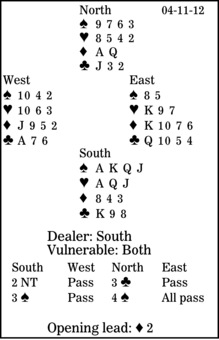Bridge column, April 11: The dummy can guide the defense

Sometimes, though, the bidding will not make it obvious which way to turn. Then you must wait for the dummy. Is it the minimum for the bidding? Is it balanced? If you answer "yes" both times, go passive. But if it has extra values or has either a strong side-suit or a short suit that will provide ruffing tricks, you need to be active, trying to win tricks as quickly as possible.
South is in four spades. West leads the diamond two. What should East do after taking dummy's queen with his king?
Since North has almost all of his points in his doubleton, I would have raised to three no-trump, not used Stayman. But that contract would have had no chance after a diamond lead (or a spade or low club, for that matter).
Into which category does the North hand fall?
Right, it is balanced with no source of establishable tricks. There is no need to be active. After taking the first trick, East should defend passively by returning a diamond or by shifting to a trump.
Yes, declarer can still make his contract if he plays double-dummy, as if he could see all 52 cards. But in the real world, he is almost certain to go down. The curious may work it out. But the main point is that with the relatively flat dummy, do not go active; stay passive.
** ** **
COPYRIGHT: 2012, UNITED FEATURE SYNDICATE
DISTRIBUTED BY UNIVERSAL UCLICK FOR UFS

